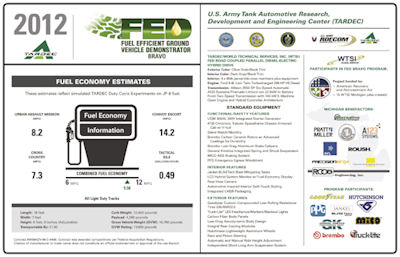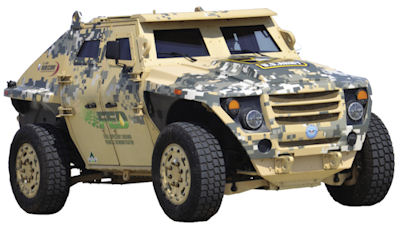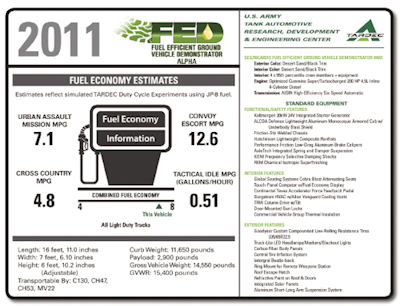Saving Fuel Saves Lives
The U.S. military consumes almost incalculable amounts of diesel and gasoline. The U.S. Army Tank Automotive Research, Development and Engineering Center is looking for ways to reduce that appetite.
Latest News
June 1, 2013
The U.S. military has been operating a test fleet of hydrogen fuel cell vehicles on the Hawaiian island of Oahu for about two years now. The joint project is funded by the Office of Naval Research, the Air Force Research Laboratories and the U.S. Army Tank Automotive Research, Development and Engineering Center (TARDEC) in cooperation with General Motors.
“The vehicles are Chevy Equinoxes,” says TARDEC project engineer Steven Eick, “with the engine and powertrain replaced with a fuel cell and electric drive, and the gas tank swapped out with high-pressure hydrogen storage tanks. Other than that, they’re unchanged for the most part.”
Well, there’s also the contemporary camouflage and the words “FUEL CELL” written large across the doors and windshields. “That’s part of our marketing,” says Eick. “We want people to identify them as fuel cell vehicles.
“We’re looking at durability and performance over time,” Eick continues. “We wanted to get a large enough sample size so we felt comfortable with the results.”
The program has 16 fuel cell vehicles deployed on Oahu—five in the Navy, five in the Air Force, and six in the Army. All are running the same GM-developed electric motors and 100 kW proton exchange membrane (PEM) fuel cells. The island provides a convenient location for all three services to work jointly, sharing information and hydrogen.
The Challenge of Hydrogen Gas Stations
Each of the three services has built or is building a hydrogen refueling station on Oahu.
“One of the reasons we wanted to focus our efforts here,” says Eick, “is we would be able to cover the entire island with just three stations.”
And yet the biggest challenge has been the availability of hydrogen fuel. “We definitely haven’t had as much success in getting full-fledged refueling systems in place as we had anticipated,” he admits. “They are very complex systems, and take a lot of design and approval from the base. You’re storing a large amount of flammable gas under high pressure. On top of that, you have to do a very controlled refueling, controlling the rate of flow of hydrogen, so you’re not generating excess heat or pressure, and a lot of that is control system structure that has to tie in with all the safety factors. All that has to come together in one location.”
Moreover, Eick says, the design and control is different from station to station, depending on available equipment, refueling protocol and the vehicles being refueled.
 The FED Bravo is a hybrid electric vehicle designed for everything from urban assault missions to convoy escort. |
The vehicles’ fuel tanks hold about 5 kg of gaseous hydrogen pressurized to 10,000 psi. That idea is bound to make some people nervous.
“People did have a bit of learning to do to get comfortable with hydrogen,” Eick states. “That’s part of what this program is about—introducing people to the technology, getting them familiar with hydrogen the same way people had to get familiar with gasoline.
“We provide training to first responders, to drivers, to any individuals that have an interest—to let them know what the safety factors involved in the vehicle are.”
Performance Results
Despite seeing a lot of use on installations where the top speed is about 35 mph, the vehicles deliver between 25 and 40 mpg—nearly double that of standard vehicles in the same roles. (1 kg of hydrogen is roughly equivalent to 1 gal. of gasoline.) And they’re holding up very well.
“We’ve seen about 98% availability of these vehicles,” says Eick, adding that’s as reliable as any standard vehicle in the government fleet.
Unlike, say Humvees, these vehicles are intended strictly for administrative use. “We’re trying to demonstrate the technology in real-world situations with the soldiers,” says Eick, “without it being in our tactical vehicles. In the short term, we don’t want to add a second fuel for our combat and tactical vehicles.”
The FED Method
Because practical hydrogen power is still a ways off, TARDEC’s Fuel Efficient ground vehicle Demonstrator program (FED) takes a very different approach to weaning the military off of diesel. Two very different approaches, in fact—using conventional fuel in less-conventional vehicles.
“The idea of the FED program,” says FED Team Leader Carl Johnson, “was to create a concept vehicle that was as fuel-efficient as possible but could still do a military mission. I couldn’t deliver the University of Michigan solar car; that really doesn’t have any military function.”
TARDEC took basic requirements from the military’s Humvee and Joint Light Tactical Vehicle (JLTV) and boiled them down to a small set: acceleration, braking, passenger capacity, etc. Using those requirements, they developed two different fuel-efficient vehicles—the Alpha and Bravo—in two very different ways.
 Key features of the FED Bravo. Instead of city and highway miles, the fuel economy label on FED vehicles includes urban assault, cross country and tactical idle. |
The Alpha’s development was analytical, with tons of computer models running hundreds of thousands of simulated miles to determine the fuel efficiency sweet spot. “It was a very rigorous, textbook, system engineering approach,” says Johnson.
The Bravo’s development was much more subjective. “I call it the ‘Monster Garage process,’” says Johnson. “We took a lot of very smart people ]who were] subject matter experts, threw them in a room and said, ‘If you were going to make a vehicle fuel efficient, how would you do it?’”
The resulting Alpha is a conventional vehicle, with a modern diesel engine and six-speed transmission. Bravo is a parallel, road-coupled hybrid electric vehicle with an electrified front axle, and an electrified and mechanical rear axle.
 The FED Alpha uses a modern diesel engine and high-efficiency six-speed automatic transmission to achieve 70% better fuel efficiency than a Humvee. |
Simulations showed the Alpha getting 70% better fuel efficiency than a Humvee, while the Bravo vehicle showed a 90% improvement. The Alpha’s trip through the Army’s Aberdeen Proving Ground (APG) yielded real-world results that were actually slightly better than the simulated numbers.
Seventy percent improvement is pretty good, but if you want that extra 20% the Bravo gets you, it comes at a very high complexity cost. “Because it’s a hybrid system,” says Johnson, “you need a battery pack, and you need a cooling system for your electronics, battery pack and motors. It gets very, very complicated. But it gets you very, very high fuel efficiency.”
Belts Begone
The team took a whole system approach to wringing fuel economy out of the more standard Alpha, without degrading performance.
“We got rid of all the belt-driven accessories on the front end,” says Johnson. “The air conditioning compressor, the power steering, the water pump. All those things have been electrified so they can be controlled and turned on and off as needed.”
Both vehicles sit on aluminum frames from Alcoa, and roll on custom Goodyear low rolling resistance tires—the only low rolling resistance tires Goodyear has ever made for the military. Aerodynamic touches were added where possible.
 Key features of the FED Alpha. That’s right, kids—it’s got an integral bustle-back and an escape hatch. |
It all adds up, Johnson reports, but then there’s the human factor: “You can ]achieve] all these incremental 5% improvements, and a bad driver will wipe all that out.”
He cites studies done by the over-the-road trucking industry that show the difference in fuel efficiency can vary as much as 30% among drivers.
“Most of our drivers are 19-, 20- and 21-year-old kids, and they’re probably going to be driving the vehicle inefficiently,” he says.
A vibrating gas pedal warns of low fuel economy, but driver training is a bigger part of the equation. “It’s not a comfortable feeling to refuel out in the middle of someplace you can get shot at,” says Johnson. “If you tell them, ‘Drive more efficiently and you’ll have to refuel less,’ that gets through to them.”
Life-saving Efficiency
“Look at what’s delivered to the battlefield most,” Johnson continues. “Everybody thinks it would be bullets; it’s actually fuel and water. I can’t tell the soldiers to drink less water, but if I can improve fuel economy so there are fewer convoys, fewer soldiers in harm’s way.” In fact, he says, a mere 1% increase in fuel economy translates into 6,000 fewer soldier trips in fuel convoys.
“It compounds as you roll out fuel economy savings across your fleet,” says Johnson. “You need fewer mechanics. Fewer truck drivers. That’s fewer soldiers I have to deliver water and food to. That logistical footprint gets smaller and smaller.”
“It’s good that we will be saving taxpayer dollars,” says Army contractor John Wray. “And it’s good that we’re being solid stewards of our environment. But it’s great that, through fuel efficiency, we’ll be saving soldiers’ lives.”
Contributing Editor Mark Clarkson is DE’s expert in visualization, computer animation, and graphics. His newest book is Photoshop Elements by Example. Visit him on the web at MarkClarkson.com or send e-mail about this article to [email protected].
More Information
Subscribe to our FREE magazine, FREE email newsletters or both!
Latest News
About the Author
Mark ClarksonContributing Editor Mark Clarkson is Digital Engineering’s expert in visualization, computer animation, and graphics. His newest book is Photoshop Elements by Example. Visit him on the web at MarkClarkson.com or send e-mail about this article to [email protected].
Follow DE




